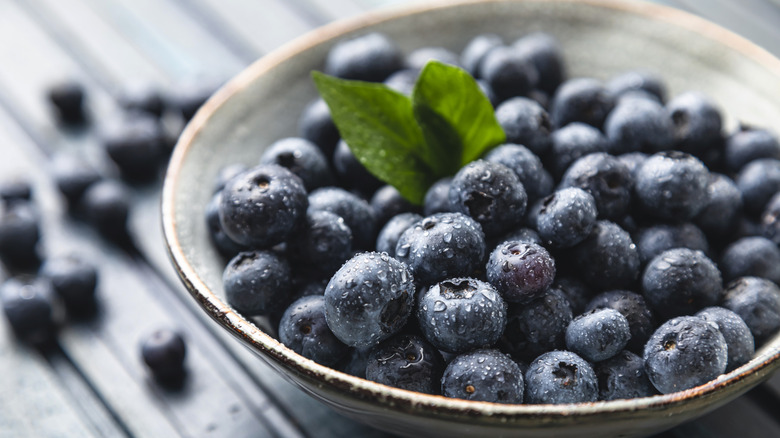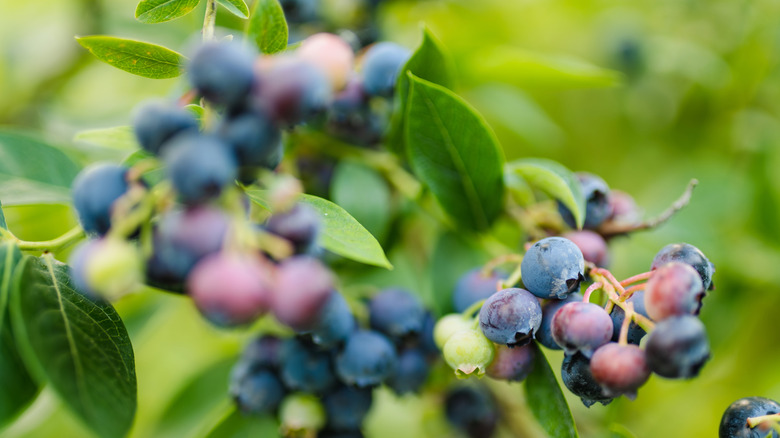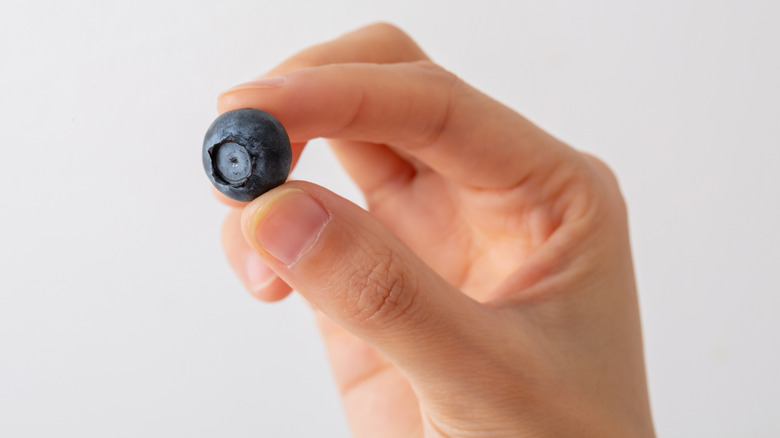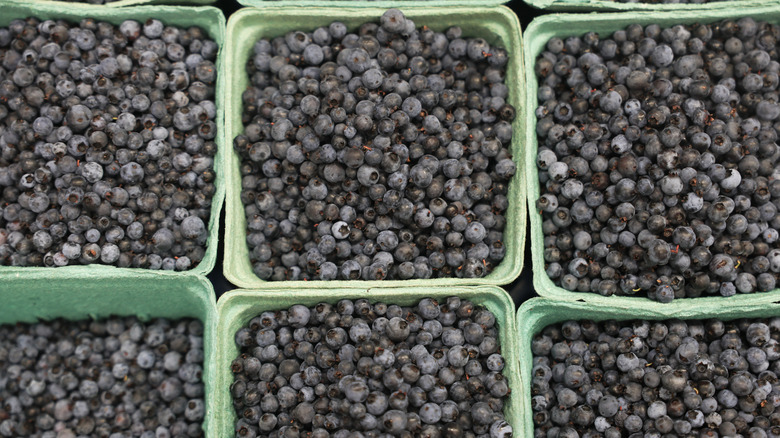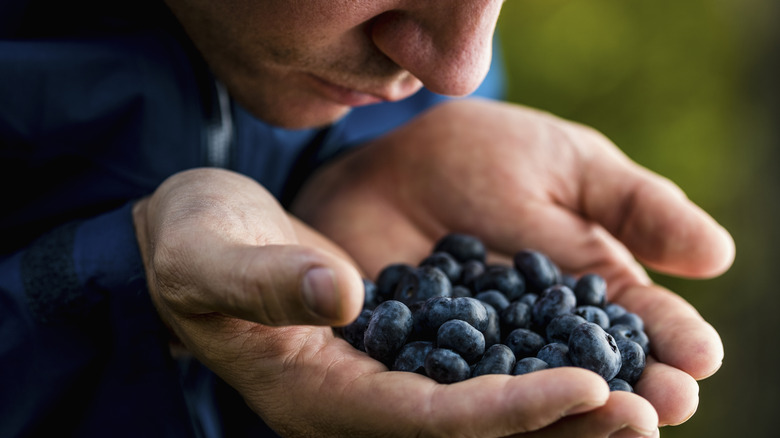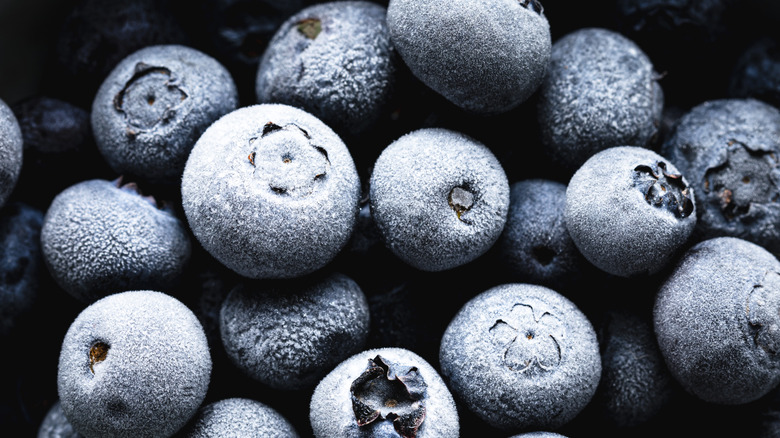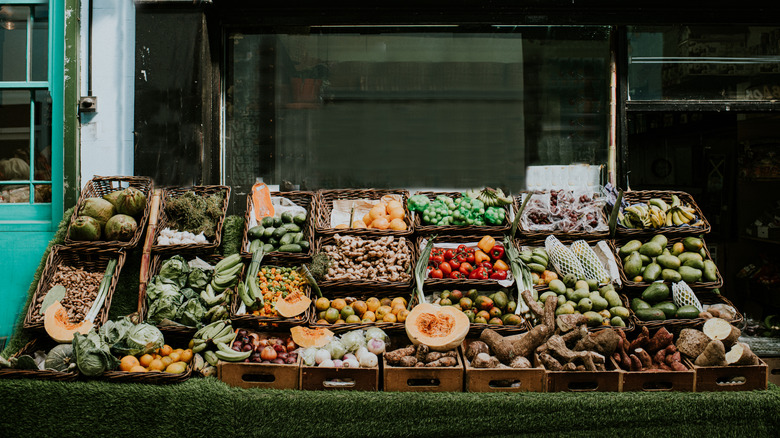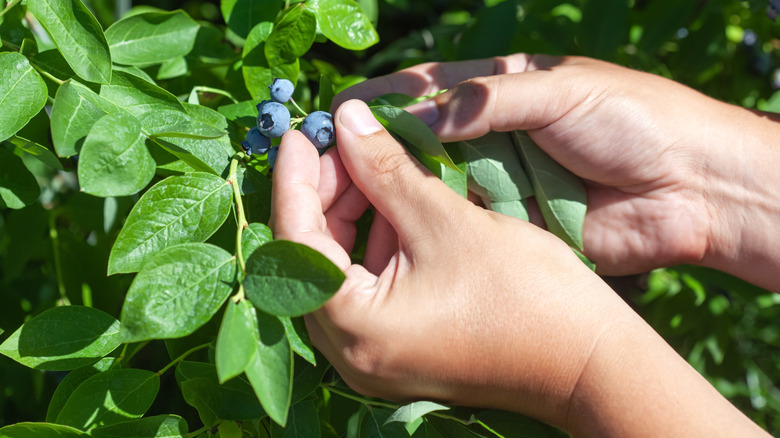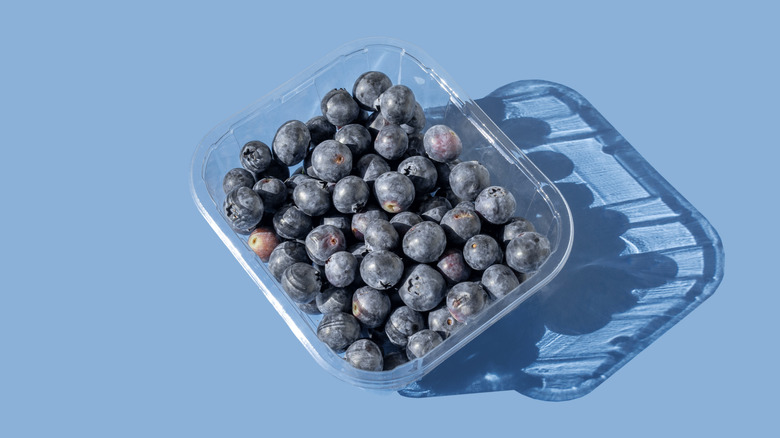Expert Says Stop Making These Mistakes When Picking Out Blueberries
Blueberries are a versatile fruit that can be used in numerous dishes — from blueberry pie to healthy fruit smoothies and beyond, the sky is truly the limit. But, unfortunately, many people don't understand how to pick out blueberries. This can lead to wasted produce, disappointment, and an unnecessary loss of money.
During my time, I've picked, chosen, and used an innumerable amount of blueberries. Not only did I grow up on a farm, but I also live right next to the blueberry capital of the world, Hammonton, New Jersey. Plus, I used a lot of fresh berries when I worked in bakeries for more than a decade. All of this time spent around these delicious little fruits means I've learned how to choose the best options — mostly through trial and error. And now, you can learn from my experience and, of course, my previous mistakes.
I'm sharing with you some common blunders people make when picking out blueberries and advice for what to do instead. Use these tips to ensure you only choose the best, perfectly ripe options on your next trip to the grocery store. Ready to get started? Let's get into it.
Choosing underripe or overripe berries
Choosing underripe or overripe blueberries is easy to do if you don't know what you're looking for. But, underripe berries will be red or red-tinted, potentially even with green hues. Overripe berries are wrinkly and may appear stained. If they're really overripe (i.e. starting to go bad) then the berries may have started splitting or bursting open. In either situation, the taste of your produce will be off. It may be too sour, too sweet, or even taste rotten.
When looking for perfectly ripe berries, you want to find ones that are a deep blue. Sometimes this may appear slightly purple tinted in direct sunlight. If you touch one, you'll find that the blueberry is soft but not mushy — it shouldn't rip, burst, or ooze when gently held between two fingers.
There should also be a powdery film across the entire surface of the berries, which is the best indicator that berries are ripe. This powdery white substance is called the "bloom" and it's a natural protective covering that forms once the fruit is done growing. Waxy in nature, the bloom will protect against moisture loss, pest infestations, and rapid deterioration.
Not checking your berries
There's a lot of things that you just grab and throw into your cart during grocery shopping, without ever giving it a second look. Your potato chips, fresh baked cookies, and even your lunch meat are prime examples. Blueberries should not be one of those things, however.
Before placing a container of blueberries in your cart (or grabbing some from the farmer's market), make sure to thoroughly inspect them using the tips presented in this article. In fact, you should be checking all of your fresh produce before purchasing them since these items have a tendency to go bad.
Without inspecting your berries, you're more likely to run into issues once you either get home or later, when you go to eat them. The most obvious issue is wasted food, which translates to wasted money. But, you may also end up with low-quality berries that, while edible, aren't as tasty as they could be. Finally, not checking your berries could lead to accidental ingestion of rotten produce by yourself or another household member. In turn, this could potentially lead to a food borne illness.
Purchasing fresh blueberries when they're not in season
One of the most common mistakes when picking out blueberries is purchasing fresh ones when they aren't locally (or even nationally) in season. Doing this has several drawbacks, but the most important one is that the berries won't taste as good because they're likely older, transported farther distances, or both. Another issue is that you'll pay a lot more money on produce that's significantly more likely to be bad.
Blueberry season can vary slightly based on your location, but will generally run between April and September nationally. That means the end of spring through the beginning of fall will generally be your best bet for getting ripe, in-season berries.
If you want to have access to fresh blueberries year round, consider purchasing them in bulk while in season and freezing them. To do this, wash your berries and dry them before lining them up on a metal sheet tray. Place the sheet tray into the freezer for a few hours until the berries are frozen and then transfer to a freezer-safe storage container. You can even use a vacuum sealer after the berries are frozen to ensure maximum freshness longer.
Assuming bigger is better
Many people assume that bigger blueberries will have a better taste. While this might be true with some things (and even with some other fruits), this is a fallacy when it comes to blueberries.
There's no correlation between blueberry size and taste. A small blueberry could be the best you've ever tasted, while a large one may lack the bold flavor profile you were hoping for. While there's never any guarantee on which blueberries will be the most tasty, there are a few things you can look for to increase the chances of finding a delicious berry.
Most of the things to look for will be the same indicators of ripeness. You want to find a berry with a fully-formed bloom, that's soft but not squishy to the touch. But, you'll also want to find the berries with the deepest blue you can find — the deeper, the better. This usually tells you that the berry will have a full-bodied blueberry taste that's sweet and a little tangy.
Ignoring the smell test
Before you take those blueberries home with you, make sure you give them the smell test. This can be done before or after your visual inspection. I personally prefer to give my berries a very brief once over before smelling them and then moving on with the in-depth visual inspection. Why? Because I believe smell is one of the great indicators of ripeness (or rottenness) for berries and all other fresh produce.
A ripe blueberry will primarily have a sweet, fruity smell, which should be punctuated with hints of tartness. There may be a mild to moderate earthy aroma, like dirt or trees — this is especially true if purchasing fresh from your local produce stand. The scent should be pleasant and not dissimilar to mixed berry juice that you find in the store.
Blueberries that have gone bad will most often have a sour smell to them, like they've been fermented. This will be an unpleasant smell and may even be bad enough to make you gag in severe instances.
Skipping out on frozen blueberries all together
While there's nothing quite like the taste of fresh blueberries, frozen blueberries are an excellent alternative that shouldn't be overlooked completely. By purchasing frozen blueberries to supplement your fresh produce, you can have access to this fruit all year round. These are especially great during the off-season, when fresh berries aren't a good alternative. Or, if you freeze your own during the season, you can fall back on commercially frozen options when you run out of your own.
Using frozen blueberries is a little different than using fresh, but they can work in many of the same recipes. In fact, I prefer frozen for my blueberry pancakes and blueberry muffins because they seem to impart more flavor into the surrounding dough via juices as they cook. They're also a much more efficient option for smoothies, where using frozen fruit means you don't have to add ice.
Bypassing the produce stand
You may do most of your weekly shopping at the grocery store, but I highly recommend using your local produce stand for blueberries and other fruits and vegetables. By purchasing your blueberries locally, you'll receive several personal, economical, and environmental benefits.
For you, local blueberries will likely be fresher (maybe even newly picked that week), and more affordable. The reason local produce is often cheaper is because you aren't paying additional costs on things like marketing, branding, or transportation. Speaking of transportation ... buying locally also decreases emissions used during long distance travel, so it's better for the environment.
The best part of buying local blueberries is supporting your local economy. Small farmers rely on community support to keep going and your purchase makes a big difference. Getting delicious, nutritious blueberries while also helping the environment and community? Sounds like a winning situation all the way around to me.
Failing to look for U-Pick Farms
If you want to save the most money and have a more hands-on experience picking out your blueberries, U-Pick Farms are an excellent alternative to produce stands. You'll still receive the same economical and environmental benefits as going to a produce stand, but the costs will generally be even cheaper because you're doing the labor yourself. Often, you get to pick your blueberries in bulk, too, so you'll receive plenty to freeze or create canned goods with.
If you choose a U-Pick Farm, you'll need to know how to pick the berries. Some places will have someone to show you, but having basic knowledge before going is a good idea. For starters, look for signs that the blueberries are ripe — a deep blue color, the bloom, and no signs of spoilage, as described above. Then, gently pull on the berries using two fingers. They shouldn't be hard to get off the bush. If they are, they aren't ready to be picked and you should move on to the next one.
Believing your blueberries will continue to ripen at home
Many fruits continue to ripen at home after they've been picked. Take bananas and avocados, for example, which can sit and ripen for a few days to even a week or more before being ready to eat. But, this process doesn't reign true for all fruits, and blueberries are one of those. Once a blueberry is picked, it no longer ripens and its next phase is to begin spoiling.
Once again, this highlights the importance of looking for signs of ripeness before purchasing (or picking), as mentioned above. It also means that using up your recently purchased blueberries is critical. If you purchase in bulk, like at a U-Pick Farm, consider experimenting with some new recipes — there are plenty of ways to use blueberries! For example, consider trying this Chocolate Blueberry Crepe recipe to satisfy your sweet tooth, or add fruit to your diet without the bold flavor with these Sneaky Joe Sliders. Your taste buds and your health will thank you.
